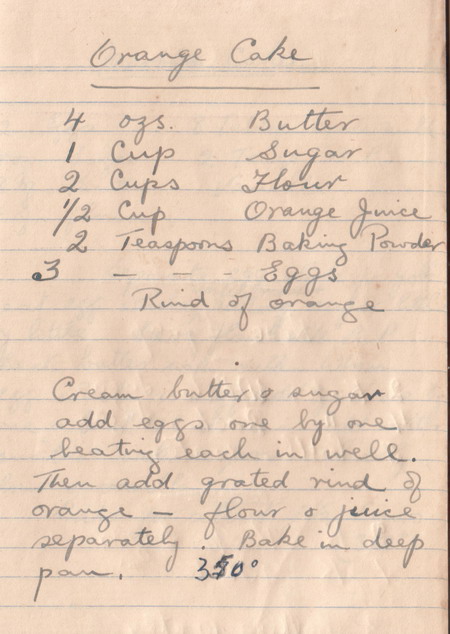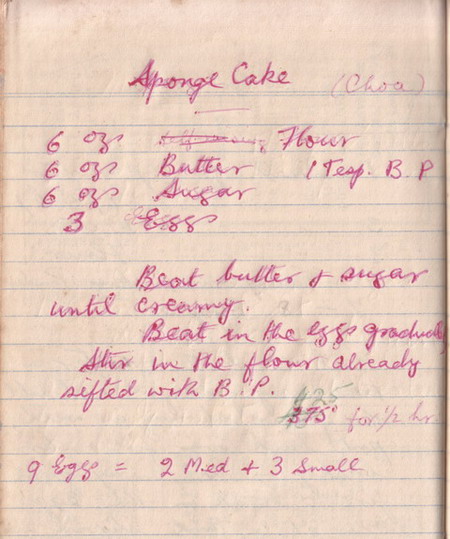A straightforward recipe here. Wonder how the texture compares with the many other cake recipes from grandmother’s notebook?

Posted in baking powder, butter, egg, orange juice, orange rind, sugar, sweet, wheat flour on January 17, 2008| 3 Comments »
A straightforward recipe here. Wonder how the texture compares with the many other cake recipes from grandmother’s notebook?

Posted in butter, cake, cocoa, sugar, vanilla, wheat flour on January 15, 2008| Leave a Comment »
Do compare this with the earlier recipe for Marble/Marmer Cake. Both recipes are noticeably generous with the use of eggs, but this one has fewer ingredients. Most importantly, this recipe doesn’t include any raising agent, which indicates that the rise is completely dependent on:
a) the creaming process – remember to cream butter and sugar till extremely light & fluffy, and add the egg yolks a teaspoonful at a time to prevent emulsifying;
b) the whisked egg whites – beat till ‘medium peak’ stage where the whites are still glossy and smooth but distinct marks are left by the whisk as you beat and when lifted, the peaks can hold their shape for a while (this is before you get to ‘hard peak’ stage where the tips of the whites are more pointed). Baking at Home with The Culinary Institute of America says,
This is the ideal stage for foams to be folded into batters… since the whites are still flexible enough to expand without bursting as they get hot.
And of course, fold in the flour and whisked egg whites very gently to prevent knocking out the air from the batter.
There are no instructions for doing the marbling, but of course, grandmother knew the technique well enough not to have to write it down in these notes to herself. One way to do it is to remove a third of the batter, add in the cocoa powder. Then pour the cocoa batter into the bowl of plain batter and swirl lightly before pouring the mix into a baking tin.
Speaking of baking tins, grandmother’s recipes often don’t specify the size of baking tin to be used. According to British cooking guru, Delia Smith, this is a typical problem of heirloom recipes:
One of the primary reasons why cakes sometimes fail is the recipe itself. It might be wrong or simply too vague, like some of grandma’s hand-me-downs which never mention details like tin sizes or oven temperature.

Posted in baking powder, butter, cake, egg, milk, sweet, wheat flour on January 13, 2008| Leave a Comment »
Like the first Sponge Cake recipe, this is one that grandmother got from a friend, noted here as ‘Mrs Tsiang’.
This sponge cake recipe is quite different from the first Sponge Cake and the Banana Sponge Cake recipes I posted earlier. Those follow the classic Victoria Sponge Cake in having equal amounts of butter, sugar and flour.
Interestingly, this particular sponge cake recipe can be either baked or steamed. If baking, 375ºF/180ºC is probably a good temperature to use, as with the Banana Sponge Cake. If steaming, don’t forget to make sure the water is really boiling and on high heat before putting the cake in and make sure there is plenty of steam so that the cake will rise properly.

Posted in baking powder, butter, cake, egg, sugar, sweet, wheat flour on January 13, 2008| Leave a Comment »
This is the first of two different plain sponge cake recipes which grandma got from her friends. You can see this one is labelled as Mrs Choa’s recipe.
The method is identical to the Banana Sponge Cake recipe which was one of grandma’s signature dishes. The equal quantities of butter, sugar and flour as well as method in these two recipe are the same as the classic Victoria Sponge Cake. Read more about the history of Victoria Sponge Cake, which is considered by some to an icon of British culture.
From my own experience with the Banana Sponge Cake, it’s very important to do the creaming properly. Cakes require the fat and sugar to be thoroughly beaten until very light and fluffy so don’t be impatient, and be careful to add the egg very gradually to prevent the mixture emulsifying. (Read more about the creaming method here and here.)
I’ve successfully used 375ºF/180ºC for the Banana Sponge Cake, so I wonder why grandma changed the temperature to 425ºF from the original temperature. I also don’t understand the notes which equate 9 eggs to ‘2 Med + 3 small’.

Posted in butter, cashew nuts, coconut shredded, egg, sago pearls, sugar, sweet, vanilla, wheat flour on January 9, 2008| 1 Comment »
In a recent comment here, one of our readers requested for grandma’s recipes for Chinese New Year goodies. Well, grandma never did much CNY baking in my memory and the recipes in her notebook seem to reflect this as well.
However, I have just come across this cut-out from the newspaper, most likely The Straits Times from sometime in the late 1950s or 1960s, which has two CNY recipes submitted by readers. This must be from the same food column which published the Christmas Pudding recipe.
With Chinese New Year less than a month away, you might want to have a go at these two recipes: ‘Toothless Delight”, which is actually a ball of sago pearls rolled in coconut and the familiar CNY cashew nut cookies, although the recipe here in fact comes from an Indian reader :)!
Both the recipes come from readers in Johor state: one from Batu Pahat, the other from Johor Bahru; if this was indeed from The Straits Times, it reveals the readership of this Singapore newspaper included those in the neighbouring Malayan state. Historically, Johor had always been closely linked to Singapore in economic and social terms because of the geographical proximity, Singapore being the nearest big city (and much further back, Singapore had been part of the Johore Sultanate). After the Second World War, new political entities were created that placed artificial divisions between Singapore and Johore: the Federation of Malaya (formed in 1948, gained independence in 1957) which excluded the Colony of Singapore. However, the textures of everyday life, such as newspaper distribution and readership show that long-standing patterns continued regardless.
The ingredients in ‘Toothless Delight’ include ice cream in ‘soda flavour’ or ‘fruity pineapple flavour’. I don’t see this incorporated into the recipe instructions, so perhaps it’s for serving on the side. Read my earlier notes on the history of commercial ice cream in Singapore here.
